Abstract
The implementation of railway intelligent construction is the need of national strategic development and the demand of society. Based on the idea of system engineering, this paper proposes a three-dimensional railway intelligent construction system architecture composed of a full life cycle, management level and technical support. Based on this architecture, a “three-step” implementation path is proposed. Then, it analyzes the technology support framework required in the architecture based on Building Information Modeling (BIM), incorporating Global Positioning System (GPS) and Geographic Information System (GIS), algorithmic prediction and machine learning technology, Internet of Things (IoT) and artificial intelligence technology, big data and cloud computing technology, and the application of railway intelligent construction system architecture is analyzed by taking a railway tunnel project in Zhejiang Province of China as an example. Finally, it discusses the problems that may be encountered in the implementation of railway intelligent construction and puts forward relevant suggestions. The results show that railway intelligent construction is an essential way. At present, China’s railway intelligent construction is still in the primary stage. The design organization should do a good job in the top-level design and accumulate sufficient data for the later stage. All parties in the middle stage of construction should do a good job in the induction and integration of information and accumulate sufficient experience. In this way, we can integrate into the advanced stage and give full play to the advantages of software and hardware integrated applications such as BIM, IoT, big data, cloud computing and intelligent devices so as to truly realize the intellectualization and modernization of railway construction.
1. Introduction
After decades of development, global informatization is still accelerating at an amazing pace. At present, countries all over the world are promoting intelligent social development. Smart city construction in the United States is moving forward rapidly and continuously updated []. The UK has formulated the corresponding smart city evaluation index [], and other European countries are also constantly exploring the accurate definition of intelligent society and ways to achieve it [,,]. In 2016, the Japanese government proposed a development plan to build a world-leading super intelligent society []. South Korea launched NSSP smart city program, promoting the construction of a smart city under new technologies and new standards []. In China, a smart society has been established by the Chinese national government as the target form of social development. Its urban and rural construction is still needed to be promoted according to the new concept and new model of the digital city [,]. As the main force of urban and rural construction and an important participant in social development, the engineering construction industry must make profound changes to improve its informatization level by changing ideas so as to meet the needs of the development of a smart society [,]. Railway engineering construction is a complex system engineering, which has the characteristics of a long construction cycle, many participating units, difficult organization and high quality standards [,,,]. Railway engineering construction urgently needs to open up the interface between information technology and traditional construction and complete the intelligent construction of railway so as to promote the lean, intelligent, efficient, innovative, green and coordinated development of the railway construction process [,,].
In recent years, BIM (Building Information Modeling), Internet of Things (IoT), big data, artificial intelligence and other new-generation information and communication technologies have developed vigorously. The effective integration of new technology and traditional railway construction technology can not only give new capabilities to various production factors in the railway engineering construction system but also bring a new revolution. At present, these emerging technologies are widely used in the construction of smart construction [,,,,,]. Ning, X. et al. [] established a construction simulation model based on a virtual geographic environment to solve the spatial conflict problem arising in the planning and design phase of high-speed railroad construction, and the obtained parameters can provide a scientific method for preferring the construction plan and assessing the full-cycle performance, and improve the project design efficiency to a certain extent. Shin, M. H. et al. [] considered the application of BIM technology to the construction and maintenance phases of railroad infrastructure in Korea and verified through pilot applications that the technology has a significant effect on improving the quality of work and cost expenditures throughout construction and completion. Yang, Q. et al. [] applied the concept of information technology in railroad tunnel construction, combining numerical simulation means and information technology to select a construction plan more suitable for the characteristics of the surrounding rock and further optimize it. Shin, M. [] studied the prospects of BIM technology in the Korean railroad industry, verifying the advantages of this technology over traditional construction through field research. Silva, C. P. et al. [] introduced a simulated annealing optimization algorithm to calculate the monitoring of the forces on railroad concrete rail sleepers, based on which the safety performance of the sleepers was evaluated, and an optimized vibrating scheme was given accordingly. Yuan et al. [] studied the design of a railroad line selection scheme based on machine learning, which introduced the Dueling Double-Deep Q Learning Network (D3QN) to train the model, and the method can realize the automatic finding of the line scheme with the optimal objective function, and it has been well verified in the engineering examples.
It is not difficult to find that various projects in the railroad construction industry are forming close links with information technology, but they can only solve some practical engineering problems in fragments without forming a complete architecture. How to integrate them has become an urgent problem to be solved. To solve this problem, many scholars have also made effective attempts and achieved certain results. You [] analyzed the development bottlenecks and constraints of the construction industry and proposed a general functional architecture of intelligent construction systems based on this, which provided a theoretical basis for the design of intelligent construction systems for different engineering types. Changwei, Y. et al. [] analyzed and compared railroad construction projects in Asian and some European countries, established a corresponding risk assessment system for railroad projects and, based on this, established a BP neural network model for both continents. Shao S et al. [] constructed a three-level evaluation index system for evaluating the operations of high-speed intelligent railroads in China, which covers a number of representative indicators and a logical hierarchy of evaluation. Shi J et al. [] studied a whole life cycle technology framework based on “intelligent construction, intelligent service, intelligent management, and operation and maintenance” using a railroad hub in Chongqing, China, as an example. Tian et al. [] analyzed and researched the intelligent construction of railroad tunnels and proposed the corresponding functional architecture in five aspects, including multi-source heterogeneous geological information fusion and intelligent interpretation, intelligent evaluation of surrounding rock quality, intelligent design theory and method, intelligent construction technology and information control platform, which provide certain technical support and research ideas for decision makers and workers in the field of intelligent tunnel construction.
Although some scholars have proposed corresponding functional architectures for railroad intelligent construction, studies that integrate the whole life cycle of construction, management level and technical support are rare. Railway engineering construction is a complex project, and system engineering means are required to achieve high quality and high efficiency in the whole life cycle. Systems engineering is a method to design, develop, manage and control based on large and complex research systems for specific purposes in order to achieve the overall best, and is an effective means to solve complex problems. Therefore, for the current situation of intelligent railroad construction in China, this paper proposes a three-dimensional functional architecture that integrates life cycle, management level and technical support based on the Hall methodology in system engineering and explores the path that needs to be experienced to realize the change of architecture, analyzes the corresponding technical support architecture, introduces and analyzes part of the functions in the three-dimensional architecture with a railroad tunnel project in Zhejiang Province, China as an example, and finally analyzes the possible problems in the development and gives some suggestions. The study shows that continuing to move forward in the direction of this architecture will help to realize intelligent railroad construction as soon as possible.
2. Hall Methodology
Hall methodology, also known as the three-dimensional Hall structure, was proposed by American scholar A.D. Hall in 1969. Its emergence provides a new way of thinking for solving huge and complex problems. Once put forward, it has been widely used all over the world. Three-dimensional Hall structure divides the whole system engineering activities into seven steps: clarifying problems, establishing a value system or evaluation system, system analysis and system synthesis. The seven steps are closely linked. From the order of completing these steps and the various skills and methods required to complete the steps, it can be divided into three dimensions: time dimension, logic dimension and professional dimension (also known as knowledge dimension). Its theoretical structure is shown in Figure 1.
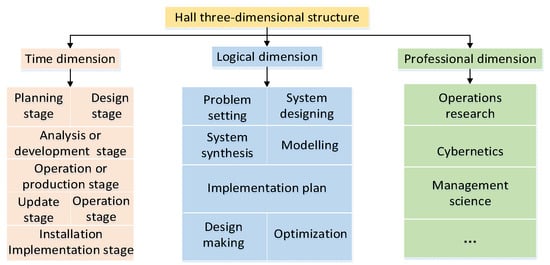
Figure 1.
Hall three-dimensional theoretical structure diagram.
In the three-dimensional structure diagram, the time dimension is the time sequence from the beginning to the end of the whole system engineering activities, which is divided into seven stages: planning, design, analysis or development, operation research or production, installation, operation and update. In each stage of the time dimension, a thinking process is required. This process is the logical dimension, which includes seven steps: problem setting, system design, modeling, optimization, decision making and implementation plan. The professional dimension lists the knowledge and skills in construction, commerce, law, management, etc., that need to be used in the implementation steps of the project. The three-dimensional structure system vividly represents the framework of system engineering research, which can be further expanded at any stage or step to form a hierarchical tree system.
3. Railway Intelligent Construction
As for railway intelligent construction, there is no unified definition in the industry [,]. In this paper, it is defined as a deep integration of various information and communication technologies (BIM, IoT, big data, cloud computing, artificial intelligence, and so on) and robotic devices with the railway construction process. Through human–computer interaction, perception, decision making, execution and feedback, it can realize the intelligent construction method of railway construction. Its characteristics [] are shown in Table 1.

Table 1.
Intelligent construction characteristics.
3.1. Transformation of Construction Mode
The traditional railway construction system consists of two parts: the human–physical system. “Human” refers to the various staff involved in the project, including the executive, management and decision-making levels, while “physics” refers to the machinery and equipment involved in the whole life cycle of the project. “Human–physical system” is to use people to directly control machines to complete different tasks. Related perception, analysis, decision making, learning and cognitive activities are completed by human beings themselves. At this stage, the physical system can replace part of human manual labor, and the amount of manual labor is determined by the level of mechanization.
Compared with traditional construction methods, the biggest change in intelligent construction systems is that a third party-information system is added between the human and physical system. As shown in Figure 2, people can indirectly control the physical system by controlling the information system. That is, an information system can replace people to do some work so as to reduce people’s work pressure and improve work efficiency. In addition, the fundamental reason why the intelligent construction system is superior to the traditional construction system is that the information system can carry out independent learning and has a self-growing knowledge base. When there is sufficient data accumulation, the information system is a “person” with rich experience, which can carry out intelligent control, intelligent analysis and decision making, and intelligent information interaction.
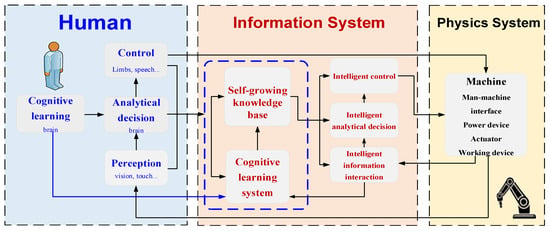
Figure 2.
Build mode of intelligent construction system.
3.2. System Architecture
The essence of railway intelligent construction is to build a set of information space, which can realize the flow of data between the information space and the physical space. It is a closed-loop enabling system that realizes the functions of state perception, real-time analysis, scientific decision making and accurate execution. Solving the complex and uncertain problems in the process of railway construction improves the efficiency of resource allocation and realizes resource optimization. Railway intelligent construction itself is a complex system with rich and colorful contents and a huge scale. Based on Hall’s three-dimensional theory, this paper constructs the architecture of a railroad intelligent construction system from three dimensions: life cycle, management level and technical support, as shown in Figure 3.
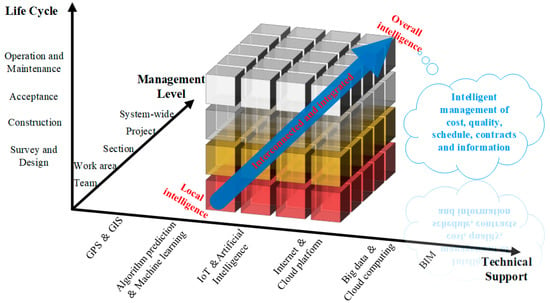
Figure 3.
System architecture of intelligent railway construction.
In this architecture, the “life cycle” corresponds to the time dimension in Hall’s three-dimensional theory. In this dimension, the whole life process of railway construction is divided into four stages in chronological order: survey and design, on-site construction, completion acceptance and operation and maintenance. An efficient and intensive management process is formed in different stages in combination with the functional dimension. The dimension of “management hierarchy” corresponds to the logical dimension in Hall’s three-dimensional theory. The whole cycle of railroad construction needs to make the next decision based on data information; for example, geographic information is needed in the survey and design phase, and the subsequent decision on relevant design parameters based on mapping data, etc. The construction phase needs to monitor key point feature values to ensure the quality of the project, and the operation phase also needs to implement monitoring, and the data obtained will also determine the management staff scheduling measures. Due to the complex nature of railway engineering construction, the data and other information are scattered and not centralized. Each professional system operates independently, which leads to the decline of the unity and security of data management. The owner cannot see the overall picture of the project construction in time and effectively. Therefore, a hierarchical intelligent construction management system dominated by the construction unit is constructed in this dimension. In this paper, it is sorted from small to large, followed by team, work area, bid section, project, whole road, research and application leading group. In a specific project, all participants participate in the project construction, obtain corresponding permissions from the system according to different needs, each participant takes what they need, and each performs its own responsibilities so as to effectively realize the efficient coordination of the project. The dimension of “technology support” corresponds to the professional dimension in Hall’s theory. The specific technologies can include BIM technology, GPS and GIS, algorithm prediction and machine learning technology, Internet of Things and artificial intelligence technology, Internet technology and cloud platform, big data and cloud computing technology, which can be used throughout the whole life cycle and all levels of management, that is, based on the system architecture to achieve cost management, schedule management, quality control, contract management, information management, etc. Various project intelligent management functions can start from a single local intelligence and eventually form a convenient and clear organic whole, and then realize the overall intelligence of business management.
Taking the local intelligence of cost management as an example, in the survey and design stage, determine the contract price of the project and the market price of resources, prepare the cost plan, control the cost in real time according to the cost plan, compare the actual cost with the target cost, and make necessary deviation correction and plan adjustment. Different from the traditional construction model, at this time, the changes correspond to the synchronous update of the whole system, and the traces of the construction process are retained. Driven by information flow as a whole, the implementation has been strengthened. It is conducive to promoting the standardization, standardization and fine management of the construction process. Based on the system architecture, engineering informatization can be greatly promoted. The key to the implementation of this model is that construction enterprises must make full use of the advantages of BIM Technology and Internet technology to build a “digital construction site”. Management personnel of all participants should pay attention to BIM visual management, dynamic integration of project management information, data interconnection, dynamic site management, etc.
4. Realization Path of Railway Intelligent Construction
4.1. “Three Steps” Strategy
As can be seen from the system architecture constructed in the previous section, the intelligent construction system first realizes local intelligence and then gradually “empowers” more and more through interconnection and comprehensive integration, with wider coverage, more and more powerful intelligent functions, and finally realizes overall intelligence. According to the development status of railway engineering construction informatization and artificial intelligence technology and the development law of intelligent technology itself, from the perspective of continuous systematization and upgrading of intelligence (as shown in Figure 4), the development process of railway engineering intelligent construction can be divided into three stages: primary, intermediate and advanced: three steps, and finally the overall realization of railway intelligent construction.
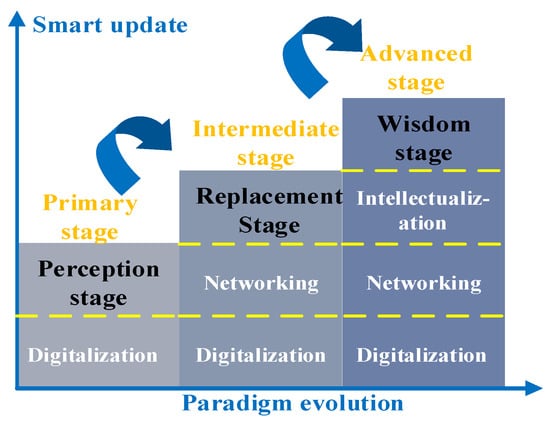
Figure 4.
Implementation path of “three steps”.
Primary stage: the “perception stage”. In the primary stage of the development of railway intelligent construction, we should take the digital manufacturing route to realize state perception. Railway participating enterprises need to actively explore the integrated application of new generation communication technologies such as the “Internet of Things”, “big data” and “mobile Internet” to form a large database of the industry and realize the digital and intelligent construction of a single project. At this stage, a project construction management platform based on the BIM model can be built based on BIM Technology and the Internet so that all participants can pay timely and effective attention to the latest developments of the project through the platform. It can effectively solve the problems such as poor information exchange in the construction of traditional projects so that all participants can cooperate through the platform. At this stage, people can get used to using modern information technology, that is, to find giants and then stand on the shoulders of giants.
Intermediate stage: the “substitution stage”. After the experience and data accumulation in the primary stage, networked manufacturing is realized on the basis of digital manufacturing in the primary stage. In this stage, the “giant” found in the primary stage is truly applied to the construction technology to realize manual replacement, effectively improve labor productivity and increase the comprehensive benefits of the project.
Advanced stage: that is, the “wisdom stage”. After the data accumulation in the primary stage and intermediate stage and the practical experience in the intermediate stage, it enters a higher “wisdom stage”. At this stage, the application of technology has been quite mature. The intelligent brain can not only know the past (based on rich databases) but also understand the present and even predict the future. At the same time, it can also make decisions for difficulties encountered. That is to realize the transformation from “giving fish” to “giving fish” in the railway industry. Truly realize the intelligent construction of China’s railway.
4.2. Intelligent Construction Technology Support
Information technology is developing rapidly all over the world, and there must be sufficient technical support to realize intelligent construction. In this paper, we combine the characteristics of the railroad construction industry, take BIM technology as the support and integrate it with other technologies to form the technical support framework of railroad intelligent construction.
4.2.1. BIM Technology
BIM (Building Information Modeling) technology is currently a popular technology in the world. The premise of China’s railway intelligent construction is the digitization of engineering information, and an important means of digitization of engineering construction is BIM technology. BIM technology is a popular technology in China, and it is also the future development trend in the field of engineering construction in China. BIM can be understood as creating a corresponding information system in the whole life process of entity construction to realize information sharing and lean construction. This information system (model, modeling and management) includes a shared database, database application (obtaining and pushing data), database creation and application standards. BIM technology is based on a three-dimensional solid model. On the basis of the 3D model, the 4D model is formed by adding progress, and the 5D model or even nd model is formed by adding cost-related information. The emergence of BIM Technology does not change the essence of design and construction in the engineering construction industry but affects the way of information transmission to project participants.
4.2.2. Other Technologies
(1) GIS and GPS technology
GIS (Geographic Information System) technology can provide a “network map”, on this basis, and the planning and site selection of railway projects can be carried out; GPS (Global Positioning System) technology can carry out three-dimensional positioning, surveying, mapping and lofting processing of projects, and it can also be used to locate railway vehicles in the later stage and implement traffic control. The transportation status, combined with the BIM management platform, can be dispatched at any time, and reasonable emergency measures can be arranged.
(2) Algorithm prediction and machine learning technology
Before construction, mature or innovative algorithms can be used to predict the key variables with the information obtained from the preliminary survey, and the prediction can also be made at the later stage of construction operation with the data collected in the preliminary stage, which can grasp the next development trend in advance and play an early warning role. At the same time, the relevant data will be uploaded to the cloud platform and other references for the management body, which helps to control the quality of the project in advance.
(3) IoT and artificial intelligence technology
Intelligent monitoring and testing equipment can be introduced, equipment communication can be realized through IoT technology, and the engineering participants themselves can obtain the final desired information without much involvement. In this process, the tedious procedure of human-operated equipment is eliminated, and the step of extracting equipment information is also dispensed with, saving time and labor to a great extent.
(4) Internet technology and cloud platform
The obtained data information is presented on the cloud platform through Internet technology, and each management level can upload and collect information related to itself, while information can be exchanged and interconnected between different levels, ultimately ensuring that each intelligent function can achieve overall collaboration and efficient completion.
(5) Big data and cloud computing technology
There are countless railroad projects all over the world, using the Internet technology to collect a large amount of data on railroad construction projects through cloud computing and big data processing technology to know about the current situation and development prospects of the industry in advance, while the development of the railroad industry will also provide corresponding reference values for other industries.
Under the traditional construction management mode, the information of all participants cannot be transmitted in time, resulting in problems such as increased cost. The emergence of BIM enables all participating units to realize effective data sharing and better collaborative interaction. Combine BIM technology with the Internet of Things, big data, cloud computing, artificial intelligence and other new-generation information and communication technologies, robots and other related equipment. Jointly serve the whole life cycle of project construction, and its combination diagram is shown in Figure 5. It is equivalent to a rehearsal before the actual construction project, which is of milestone significance in improving the project efficiency, saving the project cost and discovering the problems existing in the design and construction scheme in time.
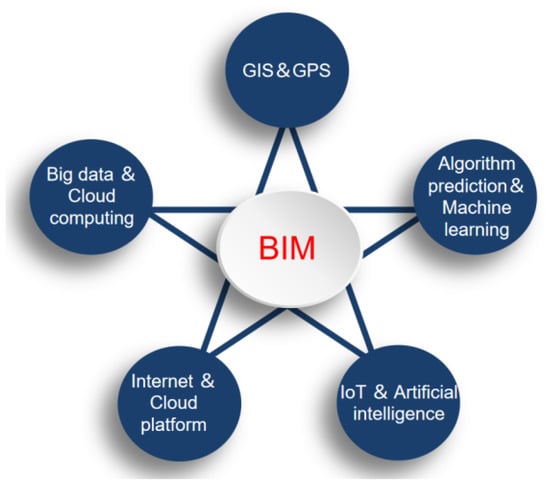
Figure 5.
Technical support framework based on BIM technology.
As a collective technology, BIM integrates planning, design, construction, management and other links into an organic whole. The emergence of this technology conforms to the trend of informatization, intelligence and information intelligence in engineering construction. BIM technology is quietly promoting the second information revolution of engineering construction and has stood at the outlet of the times. Taking BIM technology as a breakthrough has greatly promoted the information process of engineering construction. BIM technology has extended from the model as the core to the information as the core management system. It integrates all the information of an engineering project into an engineering BIM model, forming the core idea of taking the whole life cycle of engineering products as the overall management. In the BIM model, each component and each operation has a unique code, and there is a one-to-one mapping relationship between the code and the operation. So that each business in the management phase can be associated with the model. Form a substantive model integrating various information of engineering projects. All participants take what they need and perform their responsibilities so as to effectively realize the efficient coordination of the project.
5. Case Studies
The intelligent construction of railroads based on systems engineering described in this paper is dependent on the corresponding technical and economic development, so it is still difficult to fully realize such intelligent construction. A subway tunnel project in Zhejiang Province, China, has adopted a certain degree of intelligent construction platform, so this section further details the intelligent construction of railroads based on this project.
5.1. Platform Content and Characteristics
The platform contains five modules: GIS + BIM information display, construction monitoring, operation monitoring and management, maintenance management, and whole life analysis and evaluation (Figure 6). There are four major innovations: firstly, it realizes data integration and application based on BIM and GIS model, which can realize dynamic scene reproduction, correlate 3D model and physical equipment on site, map equipment operation status on 3D model in real time, truly restore real-time operation status of equipment on site, and help complete whole-life analysis and evaluation; secondly, it realizes real-time equipment perception and can gather real-time transmission construction or operation monitoring data of equipment through IOT sensors for unified analysis and display. In addition, it can help command and decision aid, with data as the driver, supported by algorithms, using expert knowledge mapping and expert knowledge experience to assist in decision making; furthermore, it can realize the support of inspection and digital intelligence through artificial intelligence and big data analysis and other technologies, realizing real-time display of equipment status, real-time analysis of data trends. Finally, it can realize the support of inspection digital intelligence, through artificial intelligence and big data analysis and other technologies, realize the real-time display of equipment status, real-time analysis of data trends, intelligent warning of defects, accurate positioning of faults, and improve the efficiency and quality of the inspection.
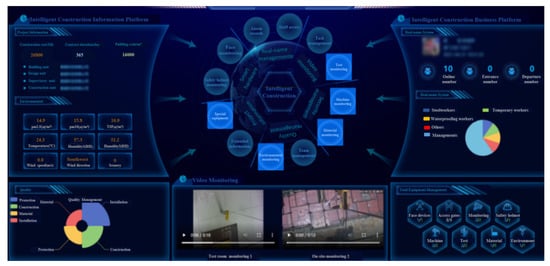
Figure 6.
Intelligent construction platform.
5.2. Model Establishment Based on GIS and BIM
The project realized the establishment of the urban metro tunnel information model based on the macro geography of GIS combined with the micro refinement of a single BIM (Figure 7). Specifically, firstly, the BIM data of the urban metro tunnel system are introduced into GIS, and the native LOD (level of detail) technology is used to parameterize the 3D objects in the BIM into a triangular network, which generates GIS models with different levels of detail. Secondly, the instantiation technology is used to optimize a large number of common objects in the BIM, combine with GIS coordinate position to realize reuse modeling, realize model lightness through data format conversion and data optimization, improve rendering efficiency and effectively support the realization of system functions.
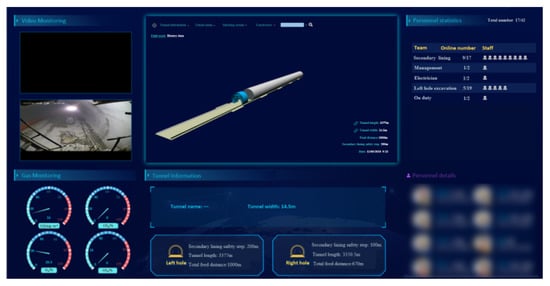
Figure 7.
Tunnel model based on GIS and BIM.
5.3. Tunnel Section Monitoring and Algorithm Prediction
Monitoring devices such as surface strain gauges, inclinometers and acceleration sensors are deployed in the tunnel section during the construction phase, and these devices, combined with technical means such as the IoT, can transmit information to the intelligent construction platform. Figure 8 shows the monitoring map of the convergence change of the section shown by the platform. In addition, based on the surface settlement monitoring data of the tunnel in the early stage, the platform has tried to introduce machine learning to build a prediction model combining two algorithms of the sparrow search algorithm (SSA) and extreme learning machine (ELM) to predict the surface settlement caused by tunnel excavation in the later stage (Figure 9), and it can be found that the algorithm has a better prediction effect in this project. The monitoring and prediction data are used to study and judge the subsequent development trend, and the platform can automatically warn in case of data abnormality and give certain solutions for reference of the project-related personnel in conjunction with big data analysis.

Figure 8.
Monitoring map of section convergence change.
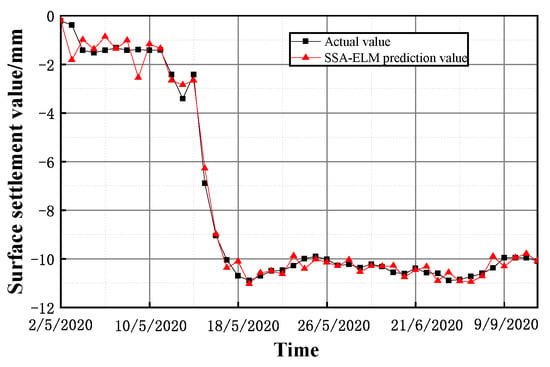
Figure 9.
Prediction of the ground surface subsidence value.
5.4. Full Life-Cycle Analysis and Evaluation
Through machine learning, artificial intelligence, IoT, Internet and other information processing technologies, monitoring data and abnormal events can be captured and implemented, and corresponding index evaluation models and performance evolution models can be formed through the built-in evaluation algorithm library of the platform (Figure 10). Carrying out implementation evaluation can further predict the future development trend and, at the same time, follow up the operation and maintenance. This cycle is repeated and followed up, forming a continuous life cycle evaluation system, and all evaluation indicators and evaluation results are presented in the model platform based on GIS and BIM.
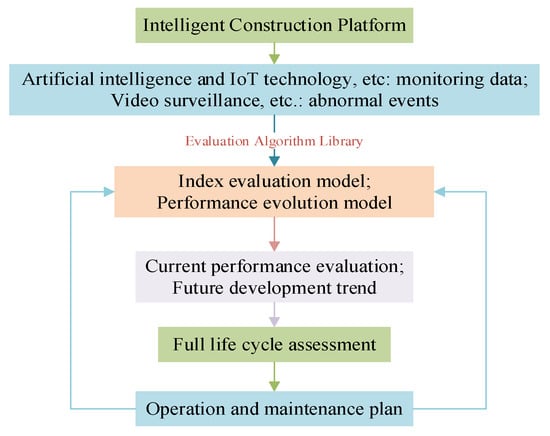
Figure 10.
Full life-cycle analysis evaluation.
In general, the construction intelligence of China’s highway industry is more prominent compared with the slow development of intelligent construction in the railroad industry, which is closely related to the characteristics of the railroad project itself. The intelligent construction platform of a subway tunnel in Zhejiang Province of China described in this section has achieved, to a certain extent, the digital tracking and evaluation of the whole cycle, but the collaboration between various management levels and the final cost, schedule, quality, contract and information intelligent management still lacks corresponding technical support, and the technology used needs to be further strengthened, so that further innovation on this basis can be considered in the subsequent development.
6. Discussion and Suggestions
The emergence of BIM technology conforms to the trend of informatization, intelligence and information intelligence in engineering construction. However, at present, the application of BIM technology in the construction field is relatively mature, but railway engineering is still in its infancy because of its strip rather than point complex nature.
Since the boom of Bim in 2003, many scholars have studied and analyzed BIM technology, covering many fields such as railway bridges, tunnels, urban rail transit and municipal administration. Some scholars have also studied the progress management, cost management, safety management and collaborative management of BIM Technology in the construction stage. Although the use of BIM has many advantages, the promotion of BIM still has a long way to go and faces many problems. In recent years, China has successively promulgated various relevant policies. With the support and guidance of the policies, various professionals continue to explore. They have been widely used in housing construction, highway, railway, water conservancy and other engineering fields and have also made some achievements. However, at present, there are still many problems, such as more early-stage exhibitions and less construction process, more effective publicity and fewer landing projects, and problems such as more pilot applications and less comprehensive development. In addition, because the railway engineering construction itself has a long construction cycle, many participants, large investment in the early stage, and the income is mainly in the later stage, it will encounter some resistance in the early implementation, which requires the regulation of national macro policies.
In addition, China’s railway intelligent construction is controlled by the development of computer technology. To realize the system architecture of railway intelligent construction, on the one hand, we should solidly complete the digital “make-up course”; on the other hand, we need to promote the development of “parallel”. It should be recognized that our informatization and digitization foundation is still quite weak. This requires relevant researchers to further study and explore BIM technology and its joint application systems with other technologies.
7. Conclusions
- (1)
- At present, many fields of engineering construction around the world are in the key period of modernization and information transformation and upgrading. In the long run, China’s railway intelligent construction is the only way. This paper gives the definition of railway intelligent construction, then constructs the railway intelligent construction system architecture from the three dimensions of life cycle, management level and technical support based on Hall’s three-dimensional theory in system engineering, and puts forward the “three-step” implementation path based on this architecture. Through the 3D functional architecture, the intelligent management functions of cost management, schedule management, quality control, contract management and information management are finally realized.
- (2)
- Taking 3D railroad intelligent construction system architecture as the guide, combined with the development situation of Chinese railroad construction, this paper proposes a “three-step” realization path. It discusses the technical support framework that needs to be taken into account to realize 3D railroad intelligent construction, that is, based on BIM, integrating GPS and GIS, algorithm prediction and machine learning, IoT and artificial intelligence technology, big data and cloud computing technology.
- (3)
- An intelligent construction platform of a railroad in Zhejiang Province, China, has achieved some of the functions proposed in this paper to a certain extent, but it can be further developed on this basis. China’s railway intelligent construction is still in the primary stage. Seizing the rare opportunity brought by the new round of scientific and Technological Industrial Revolution and accelerating the formulation of China’s intelligent railway development strategy is of great significance to continuously maintain the leading global position of China’s high-speed railway. Under the general trend of new technology and industrial revolution, it is suggested that the railway engineering construction should deeply promote the application of BIM Technology, build a solid digital foundation and at the same time integrate other technologies together to help upgrade the intelligence of railroad construction.
Author Contributions
Formal analysis and investigation, T.M.; methodology, Y.W.; writing—original draft, Z.W.; writing—review and editing, Z.W., T.M. and G.L.; resources, H.T. All authors have read and agreed to the published version of the manuscript.
Funding
This work was supported by the National Natural Science Foundation of China (grant numbers 51778633, 51308552); Science and Project of science and technology research and development plan of China Railway (grant numbers 41, 243).
Conflicts of Interest
The authors declare that they have no known competing financial interests or personal relationships that could have appeared to influence the work reported in this paper.
References
- Kubina, M.; Šulyová, D.; Vodák, J. Comparison of Smart City Standards, Implementation and Cluster Models of Cities in North America and Europe. Sustainability 2021, 13, 3120. [Google Scholar] [CrossRef]
- Woods, E.; Alexander, D.; Labastida, R.R.; Watson, R. UK Smart Cities Index—Assessment of Strategy and Execution of the UK’s Leading Smart Cities. 2017. Available online: https://e.huawei.com/uk/special_topic/solution/smart_cities_index_2017 (accessed on 9 April 2022).
- Varró, K.; Szalai, Á. Discourses and practices of the smart city in Central Eastern Europe: Insights from Hungary’s ‘big’ cities. Urban Res. Pract. 2021, 14, 1–25. [Google Scholar] [CrossRef]
- Manitiu, D.N.; Pedrini, G. Urban smartness and sustainability in Europe. An ex ante assessment of environmental, social and cultural domains. Eur. Plan. Stud. 2016, 24, 1766–1787. [Google Scholar] [CrossRef]
- Cardullo, P.; Kitchin, R. Smart urbanism and smart citizenship: The neoliberal logic of ‘citizen-focused’ smart cities in Europe. Environ. Plan. C Politics Space 2017, 37, 813–830. [Google Scholar] [CrossRef] [Green Version]
- Wang, X.; Meng, J.; Zhang, Y. Analysis on the Policy and Technology Application of Japan to Promote the Development of Intelligent Society. In Proceedings of the International Conference on Education, Singapore, 26–28 December 2016. [Google Scholar]
- Yang, J.; Kwon, Y.; Kim, D. Regional Smart City Development Focus: The South Korean National Strategic Smart City Program. IEEE Access 2021, 9, 7193–7210. [Google Scholar] [CrossRef]
- Huang, W.; Wei, Y.; Guo, J.; Cao, J. Next-generation innovation and development of intelligent transportation system in China. Sci. China Inf. Sci. 2017, 60, 110201. [Google Scholar] [CrossRef] [Green Version]
- Wang, H.; Shen, Y.; Niu, Y.; Zheng, Y. Design and research of building automation system and its system planning for green intelligent building. J. Environ. Prot. Ecol. 2019, 20, 832–841. [Google Scholar]
- Chunfang, L.U. Intelligent construction technology of railway engineering in China. Front. Eng. Manag. 2019, 6, 503–516. [Google Scholar] [CrossRef]
- Shi, T. Informatization status and intelligent development of China’s high-speed railway. Sci. Technol. Guide 2019, 37, 383–392. (In Chinese) [Google Scholar]
- Lei, M.; Lin, D.; Huang, Q.; Shi, C.; Huang, L. Research on the construction risk control technology of shield tunnel underneath an operational railway in sand pebble formation: A case study. Eur. J. Environ. Civ. Eng. 2020, 24, 1558–1572. [Google Scholar] [CrossRef]
- Ning, X.; Zhu, Q.; Zhang, H.; Wang, C.; Han, Z.; Zhang, J.; Zhao, W. Dynamic Simulation Method of High-Speed Railway Engineering Construction Processes Based on Virtual Geographic Environment. ISPRS Int. J. Geo-Inf. 2020, 9, 292. [Google Scholar] [CrossRef]
- Xu, J.Y.; Lu, W.S. Smart Construction from Head to Toe: A Closed-Loop Lifecycle Management System Based on IoT. In Proceedings of the Construction Research Congress 2018, New Orleans, LA, USA, 2–4 April 2018; American Society of Civil Enginters: Reston, VA, USA, 2018; pp. 157–168. [Google Scholar] [CrossRef]
- Yang, Z.; Ding, P.; Wang, D.; You, Y.; Qiao, J. Landslide Risk Analysis on Sichuan-Tibet Railway (Kangding to Nyingchi Section). Tiedao Xuebao/J. China Railw. Soc. 2018, 40, 97–103. [Google Scholar] [CrossRef]
- Zhao, Y. Application and development of intelligent construction based on BIM Technology in railway industry. Railw. Comput. Appl. 2019, 28, 1–6. (In Chinese) [Google Scholar]
- Bilal, M.; Oyedele, L.O.; Qadir, J.; Munir, K.; Ajayi, S.O.; Akinade, O.O.; Owolabi, H.A.; Alaka, H.A.; Pasha, M. Big Data in the construction industry: A review of present status, opportunities, and future trends. Adv. Eng. Inform. 2016, 30, 500–521. [Google Scholar] [CrossRef]
- Tang, S.; Shelden, D.R.; Eastman, C.M.; Pishdad-Bozorgi, P.; Gao, X. A review of building information modeling (BIM) and the internet of things (IoT) devices integration: Present status and future trends. Autom. Constr. 2019, 101, 127–139. [Google Scholar] [CrossRef]
- Shin, M.-H.; Baek, J.-H. Design and Construction of Rail Infrastructure BIM Integrated Management System for Systematic Management of Rail Infrastructure BIM Design Performance Products. J. Korean Soc. Railw. 2020, 23, 886–894. [Google Scholar] [CrossRef]
- Yang, Q.; Wang, Z. Information-Based Construction of High-Speed Railway Tunnel. Shock Vib. 2017, 2017, 5318785. [Google Scholar] [CrossRef] [Green Version]
- Shin, M.H.; Lee, H.K.; Kim, H.Y. Benefit–Cost Analysis of Building Information Modeling (BIM) in a Railway Site. Sustainability 2018, 10, 4303. [Google Scholar] [CrossRef] [Green Version]
- Silva, C.P.; Dersch, M.S.; Edwards, J.R. Quantification of the Effect of Train Type on Concrete Sleeper Ballast Pressure Using a Support Condition Back-Calculator. Front. Built Environ. 2020, 6, 604180. [Google Scholar] [CrossRef]
- Yuan, Q.; Zeng, W.; Li, Z.; Gao, T.; Yang, D.; He, Q. Intelligent railway line selection method based on improved D3QN deep reinforcement learning. J. Railw. Sci. Eng. 2022, 19, 7. (In Chinese) [Google Scholar]
- You, Z.; Zheng, L.; Feng, L. Basic theory and architecture of intelligent construction system. J. Civ. Eng. Manag. 2021, 38, 105–111+118. (In Chinese) [Google Scholar]
- Changwei, Y.; Zonghao, L.; Xueyan, G.; Wenying, Y.; Jing, J.; Liang, Z. Application of BP Neural Network Model in Risk Evaluation of Railway Construction. Complexity 2019, 2019, 2946158. [Google Scholar] [CrossRef] [Green Version]
- Shao, S.; Li, P.; Zhen, J. Study on the Evaluation Index System of China Intelligent High-speed Railway Based on Technical Characteristic. In Proceedings of the 2019 IEEE Intelligent Transportation Systems Conference (ITSC), Auckland, New Zealand, 27–30 October 2019. [Google Scholar]
- Shi, J.; Li, Q. “Intelligent” Technical Guidelines for Chongqing East Railway Station Building and Supporting Hub Area. Math. Probl. Eng. 2021, 2021, 6680380. [Google Scholar] [CrossRef]
- Tian, S.; Wu, K.; Wang, Z.; Wang, M.; Ma, W.; Yi, W. Discussion on the Realization Route of Intelligent Construction of Railway Tunnel in China. J. China Railw. Soc. 2022, 44, 134–142. (In Chinese) [Google Scholar]
- Fan, Q.; Lin, P.; Wei, P.; Ning, Z.; Li, G. Closed loop control theory of intelligent construction. J. Tsinghua Univ. (Sci. Technol.) 2021, 61, 660–670. (In Chinese) [Google Scholar]
- Niu, Y.; Lu, W.; Chen, K.; Huang, G.G.; Anumba, C.J. Smart Construction Objects. J. Comput. Civ. Eng. 2016, 30, 04015070. [Google Scholar] [CrossRef] [Green Version]
- Zhi, P. Research on BIM based railway construction management platform and key technologies. China Acad. Railw. Sci. 2018. (In Chinese) [Google Scholar]
Publisher’s Note: MDPI stays neutral with regard to jurisdictional claims in published maps and institutional affiliations. |
© 2022 by the authors. Licensee MDPI, Basel, Switzerland. This article is an open access article distributed under the terms and conditions of the Creative Commons Attribution (CC BY) license (https://creativecommons.org/licenses/by/4.0/).